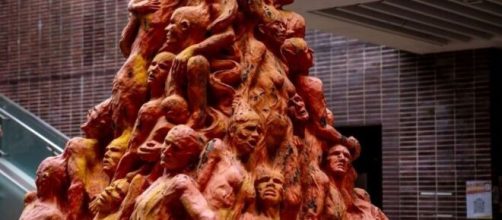Before dawn, while still obscured by night, Chinese authorities pulled down a 26-foot-tall sculpture that stood at the University of Hong Kong for the last 32 years.
Rebels with a cause
The sculpture, "Pillar of Shame," by Jens Galschiot, enshrined the victims of the '89 Tiananmen Square massacre protesting martial law. Apparently, the removal was meant to remove the memory of that dissent.
And, as if to avoid further dissent, Pillar of Shame was not only carted off in darkness but also while students at the University of Hong Kong were away from campus on their Christmas break.
As part of China's crackdown on protests last year, Hong Kong officials also ruled against commemorations of Pillar of Shame. With the statue now junked, two other universities in the city took similar action:
The Chinese University of Hong Kong toppled the statue Goddess of Democracy, and Longnan University uprooted a bas relief illustrating the Tiananmen Square massacre.
Monument men
All of these make a strong case for monuments. Their built-in attention to historical high points are vital to any country. The very fact they are objects of controversy speaks of their importance. Consider all the fuss made over our Civil War statues.
The non-art world may view art as a luxury, even as elitist. But honoring the lost brave souls of the Tiananmen Square Massacre nearly four decades ago still, embolden others to take up the fight against tyranny.
The Hong Kong statue was a measure of valor as certain as the stark, soaring obelisk honoring the leader of the Patriots to victory in the American Revolutionary War. I'm thinking of the Washington Monument.
Location, location
But here's the thing. The site on which a monument stands can help to tell the story behind it. This is why a plan proposed by The Tower of Shame sculptor Galschiot is not good.
He asked Chinese authorities to return the work to him to find a new home like the Chinese Embassy in D.C. It would send a strong message, he said. Not as strong as Tiananmen Square. Context is everything.
Consider the sorry location of Michelangelo's David, originally slated for the dome of the Cathedral of Florence, but placed in the public square and then indoors in the Galleria dell'Accademia.
Like any Grecian ideal, David is just another artful depiction of anatomical beauty in the museum setting. The Biblical tale it illustrates is mostly lost without the context of the church setting.
This is why Michelangelo carved David into a towering 17 feet with an oversized head. It was meant to be seen from below at a great distance, not up close where the eye lands so easily on the figure's genitals.
While enamored of the male body, Michelangelo was also a deeply religious man who was true to scripture by designing David specifically for a house of God. Moving it to a museum compromises its scriptural significance.
Similarly, moving the Tower of Shame to the Chinese Embassy in D.C. far from where thousands protesting the loss of liberty were mowed down, would be the same way Michelangelo's message of religious liberty is lost.


